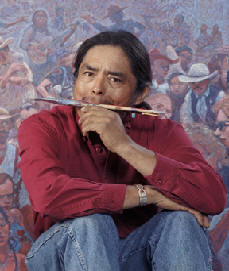In 1862, my people were rounded up and forced to walk over 450 miles to Bosque Redondo, near Ft. Sumner, N.M. This was Manifest Destiny in its glorious and ugly expansion with no regard to the preceding culture. There were four different routes that brought 9,000 prisoners eventually. Hundreds died along the trail.
In 1865, the Bosque was the most populated place anywhere in New Mexico. Four years of excruciating and marginal existence at the “reservation” saw many deaths. In the end, it was a failure at an attempt to “Americanize” us. It was deemed a monumental waste of resources, manpower and time, not to mention the hardship the soldiers endured. Our ancestors’ captivity ended in June of 1868 with a signing of a treaty agreement. Another long and arduous walk occurred coming home, avoiding slave traders and other threats.
Last week, my friend and I drove out to this place of historical pain. It took the walkers more than a month to cover the distance; we drove it in hours. The harsh landscape they negotiated worked in unison with the condition. I am brought to tears and awed by this experience simultaneously. It is a powerfully moving place. I was asked to be there for the dedication of the new museum of the government’s misguided effort to subjugate an unwanted population. On the very ground where, once, cries of the dying, and brutal barkings of orders now stands a memorial in a form of this museum: Bosque Redondo Memorial museum. It is a monument whose time is long overdue. My contribution to the memorial is two large murals depicting the Long Walk itself. Two 16-foot-by-61-foot murals will grace the wall pacifying the restless spirits still so much abound. I am locked in this way to this very important new effort to understand and to hear one another—a monument to tolerance, to compassion and respect. In a strange way, I felt its peace here along the banks of the Pecos River. The ghosts of prisoners and guards still tease my peripheral vision.
Being on the grounds that held pain, I couldn’t help but wonder why it is that the Indian war still rages, most times subtle and “excusable” especially where we are an obstacle to financial and political gains by others. I know Manifest Destiny still rules the pocketbooks of those who hold power. There are also very clear displays of colonial mindset at times. I feel that little has changed in the decades since the “Indian problem” has been eradicated: “… as long as the river shall run and the grass will grow …” this treaty was to be honored. Somewhere along the way—I don’t know when—the river must’ve stopped running and the grass ceased to grow. We were not told.
Being among all the well-intentioned people at the Bosque supporting this new museum, I felt accepted. I felt that my words will be heard and my visions respected. I shook the hands and peered into the eyes of all well wishers. I read the gestures and heard words of sorrow, apologies and gratitude. I am among friends 500 miles away from Flagstaff.
I sit here below the mighty Doo K,o oos l,iid, sometimes referred to as San Francisco Peaks. I sit here in reverence to her presence. I see her as one of the four Sacred Mountains. I see her as the Western alter of our homeland, the guardian of the sunset palette, dressed in abalone and rainbow. With a heavy heart, I also now see her as a point of controversy and division which need not be. The grand gesture of reconciliations and peace that I was a part of in eastern New Mexico seems so distant and muted in the face of what I have witness these past few years concerning the peaks. The acknowledgement of this humility and finding a spirit path out of it seems hard when you see passionate young people chained to the machinery of destruction, courageously putting it on the line. I salute you.
I made this trip to make peace with my own pain there. I washed it away in the river of Pecos.

